
Burghead is a small town in Moray, Scotland, about 8 miles (13 km) north-west of Elgin. The town is mainly built on a peninsula that projects north-westward into the Moray Firth, surrounding it by water on three sides. People from Burghead are called Brochers.

The Highland Railway (HR) was one of the smaller British railways before the Railways Act 1921, operating north of Perth railway station in Scotland and serving the farthest north of Britain. Based in Inverness, the company was formed by merger in 1865, absorbing over 249 miles (401 km) of line. It continued to expand, reaching Wick and Thurso in the north and Kyle of Lochalsh in the west, eventually serving the counties of Caithness, Sutherland, Ross & Cromarty, Inverness, Perth, Nairn, Moray and Banff. Southward it connected with the Caledonian Railway at Stanley Junction, north of Perth, and eastward with the Great North of Scotland Railway at Boat of Garten, Elgin, Keith and Portessie.

Alness railway station is a railway station on the Far North Line, serving the town of Alness, on the Cromarty Firth, in the Highland council area of Scotland. The station is 28 miles 70 chains (46.5 km) from Inverness, between Dingwall and Invergordon.
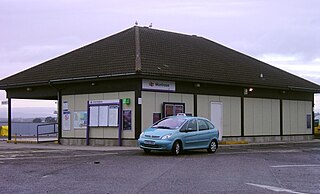
Montrose railway station serves the town of Montrose in Angus, Scotland. The station overlooks the Montrose Basin and is situated on the Dundee–Aberdeen line, 90 miles (144 km) north of Edinburgh Waverley.
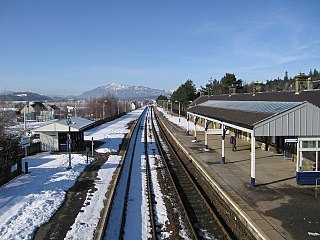
Kingussie railway station serves the town of Kingussie, Inverness-shire in the Highland Council Area of Scotland. The station is managed by ScotRail and is on the Highland Main Line, 71 miles 43 chains (115.1 km) from Perth, between Newtonmore and Aviemore.

The Morayshire Railway was the first railway to be built north of Aberdeen, Scotland. It received royal assent in 1846 but construction was delayed until 1851 because of the adverse economic conditions existing in the United Kingdom. The railway was built in two phases with the section from Elgin to Lossiemouth completed in 1852. When the Inverness and Aberdeen Junction Railway (I&AJR) reached Keith via Elgin, the Morayshire was able to complete the Speyside second phase by connecting the Craigellachie line at Orton. Initially, the Morayshire ran its own locomotives on the I&AJR track between Elgin and Orton but this was short-lived and the Morayshire carriages were then hauled to Orton by the I&AJR. Disagreements with the I&AJR eventually forced the Morayshire into constructing a new section of track between its stations at Elgin and Rothes; this was completed in 1862. The Morayshire accomplished its final enlargement by connecting to the new Great North of Scotland Railway (GNoSR) Craigellachie station in 1863. Crippling debt forced the company into an arrangement with the GNoSR for it to assume operation of the track in 1866. By 1881, the Morayshire had greatly reduced its liabilities and its long-sought-after amalgamation with the GNoSR finally took place.

Allanfearn was a railway station located near Culloden, outside Inverness, Highland, Scotland. It was initially named Culloden when opened, but was renamed to Allanfearn in November 1898, to avoid confusion with the station at Culloden Moor on the newly opened direct line from Inverness to Aviemore.
The Inverness and Aberdeen Junction Railway (I&AJR) was a railway company in Scotland, created to connect other railways and complete the route between Inverness and Aberdeen. The Inverness and Nairn Railway had opened to the public on 7 November 1855 and the Great North of Scotland Railway (GNoSR) was building from Aberdeen to Keith. The I&AJR opened, closing the gap, on 18 August 1856.

Alves was a railway station located near Elgin, in the Scottish administrative area of Moray. The station was the junction where the line to Burghead and Hopeman diverged from the line from Aberdeen to Inverness.

Portessie railway station was a joint Highland Railway (HR) and Great North of Scotland Railway (GNoSR) station at the junction between the Moray Coast Railway and the Buckie and Portessie Branch which also served the small fishing village of Portessie, in the parish of Rathven, Scottish county of Moray.
The Killiecrankie railway station served the village of Killiecrankie, Perth and Kinross, Scotland from 1864 to 1965.
The Banff, Portsoy and Strathisla Railway was a Scottish railway company that connected the Aberdeenshire ports of Banff and Portsoy with the main line of the Great North of Scotland Railway (GNoSR) main line at Grange, a place some distance east of Keith. The railway opened in 1859, and was renamed the Banffshire Railway in 1863 when the GNoSR began running services.
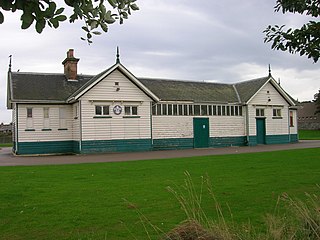
Portsoy railway station was a railway station in Portsoy, in current day Aberdeenshire. Opened in 1859 by the Banff, Portsoy and Strathisla Railway, it was absorbed by the Great North of Scotland Railway in 1867. The original terminus closed in 1884 and a new station opened nearby on a through route and two years later, after the Moray Firth coast line opened, the station was served by Aberdeen to Elgin trains.
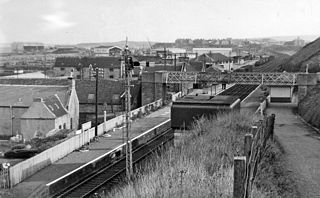
Buckie railway station was a railway station in Buckie, in current day Moray. The station was opened by the Great North of Scotland Railway (GNoSR) on its Moray Firth coast line in 1886, served by Aberdeen to Elgin trains.
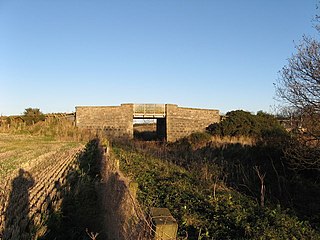
Tillynaught railway station or Tillynaught Junction was a junction railway station in what is now Aberdeenshire, Parish of Fordyce, 6 miles south-west of Banff. Tillynaught was opened in 1859 by the Banff, Portsoy and Strathisla Railway, and in 1867 was absorbed by the Great North of Scotland Railway(GNSR). This junction station was served by Aberdeen to Elgin trains as well as trains running to the branch terminus at Banff.
Murdoch Paterson was an engineer and architect based in Inverness, Scotland, who was chief engineer of the Highland Railway.

Hopeman railway station served the village of Hopeman, Moray, Scotland from 1892 to 1957 on the Highland Railway's branch line from Alves.
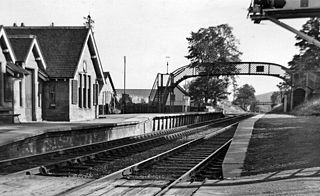
Bunchrew railway station served the village of Bunchrew, Highland, Scotland from 1862 to 1964 on the Inverness and Ross-shire Railway.
Coltfield Platform railway station stood on the Burghead and Hopeman Branch of the Inverness and Aberdeen Junction Railway and later the Highland Railway that once served the rural area of Coltfield and Wards in the Scottish district of Moray. It was opened as Wards railway station in 1862 and was renamed as Coltfield railway station in 1855 before finally becoming Coltfield Platform in 1880. The station lay 2 mi 20 chains from Alves railway station.
Cummingston railway station stood on the Burghead and Hopeman Branch of the Highland Railway and once served the small village of Cummingston, formerly Cummingstown, in the Scottish district of Moray.














